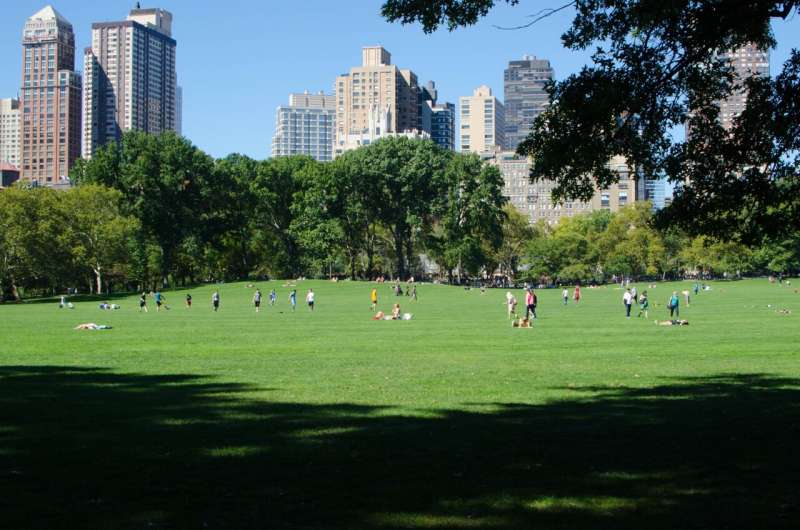This article has been reviewed according to Science X's editorial process and policies. Editors have highlighted the following attributes while ensuring the content's credibility:
fact-checked
trusted source
proofread
Questioning cities that create wealth disparities from the perspective of the 'excluded'

Cities are reborn in the wake of international mega-events such as the 2021 Tokyo Olympics, the G7 Hiroshima Summit in 2023, and the upcoming Expo 2025 in Osaka. Areas around stations, parks and roads are redeveloped, hotels and shopping buildings are constructed, and high-rise condominiums are erected that overlook the city. The orderly space stimulates consumption and creates a bustling atmosphere.
"Isn't there something that's being overlooked?" says Haraguchi Takeshi, an associate professor at Kobe University's Faculty of Letters.
"Every city around the world has poor people and marginalized communities in its periphery. When a development project kicks off in an area where they've been living for a long time, it gradually gets transformed into an area for the rich. This process is known as 'gentrification.' The major issue lies in the eviction and exclusion of the original residents, who are forced out directly or indirectly."
Gentrification, which can be explained as "urban enrichment" but also as "purification policy" or "social cleansing," is a term coined by a British sociologist in the 1960s. Haraguchi witnessed the reality of gentrification in the 2000s during his fieldwork in Kamagasaki, Osaka, where many day laborers lived, and when he was involved in supporting people sleeping outside in tent villages that sprouted in the parks in Osaka City.
One example is the developments surrounding Tennoji Park near Kamagasaki. The park was originally established as the site of the "National Industrial Exhibition" in 1903 during the Meiji era (1868–1912) but was renovated and fenced off when the "Tennoji Exposition" was held again in 1987. Subsequently, almost the entire area charged admission to the facility after 1990.
"So they excluded the homeless and the workers who were living in tents. The 'Aozora Karaoke' (street karaoke parlors), which were situated in various parts of the park, kept operating with the stalls in the narrow passageway in front of the park, but they were forcibly evicted by the city of Osaka in 2003. In other parks, tent villages were being removed one after another due to major events. Seeing a place where people live being treated as trash and unilaterally eliminated made me ponder about what was really happening. That's when I started researching gentrification in earnest," Haraguchi says.
In the background, there have been shifts in society and values over the decades. The burst of the bubble economy and the economic downturn in Osaka, the decrease in daily employment, the dwindling labor movement, the growing theory of self-responsibility, and neoliberal reforms: Since the 2010s, there has been an increasing trend to make parks into spaces for earning and consumption.
"In Tennoji Park, a commercial facility called 'Tenshiba' was built in 2015, run by a private real estate company. It's true that the barriers that existed before have been removed but the space has nevertheless become increasingly inaccessible to people without money. Rather than forced removal, the essence of gentrification is to exclude people through indirect methods, such as upgrading the area, making it a consumer space, and increasing rents."
SDGs from the perspective of humanistic geography
Haraguchi specializes in geography. However, his research and discussions extend beyond maps and space, with a strong focus on people and society. He says that it is based on the ideas of humanistic geography that emerged in the 1960s and 1970s under the slogan, "Bringing the human back into geography."
He says, "In humanistic geography, we enquire about the world including the inner lives of people. Even the same place or structure can be perceived differently depending on one's position. For example, some people may be proud of a monument, while others may find it humiliating. Another important aspect is the pursuit of social justice and social equity in the city. Poor neighborhoods and upscale neighborhoods are not naturally divided, but are created by power and capitalism. How can we change that?"
In the 1990s, when he was an undergraduate and then graduate student, there was a movement for the renewal of geography. The field of geography was expanding its horizons by intersecting with various disciplines in other fields, giving birth to new branches such as phenomenological geography, Marxist geography and feminist geography. This heated atmosphere stimulated him to make Kamagasaki in Osaka the subject of his research.
"I began my research wanting to dynamically depict the history of the space known as Kamagasaki, including its formation, change and antagonistic developments. However, it became difficult for me to define the line between my research activities and my support activities. Being on site, I saw various things happening like tent villages being removed right before my eyes. I couldn't remain detached," he reflects.
Thinking back to that time now, he always looked at society from the perspective of the poor and excluded. We asked him how he sees the current global interest in the SDGs.
He answered with two more questions. First, "sustainability for whom?" If the SDGs are for a handful of wealthy people, such as large corporations and capitalists, they may lead to the exclusion and oppression of the majority of other people, especially the poor. The other question is: "How did we get into this unsustainable situation?" The SDGs have been incorporated into the theme of the upcoming Expo in Osaka without asking this question.
This is the perspective of a "social geographer" who has been observing changes in cities and parks, and who does not get caught up in superficial words and phenomena but looks for what is being covered up and questions the essence of what is happening.
Provided by Kobe University




















